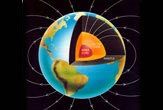Crusty Old Discovery Reveals Early Earth's History

Only in science could the discovery of something old and crusty be exciting.
And researchers are very excited about finding chunks of Earth's outer crust that are 3.8 billion years old. Most stuff that old has been folded back into the planet and lost forever or spat back out after being melted into unrecognizable magma.
The discovery, detailed in today's issue of the journal Science, provides solid evidence that Earth had crustal plates way back then that were banging into each other much as they do today in a process that drives earthquakes and reshapes continents. That activity, and the chemical changes to land, sea and air that accompany it, are thought to have been crucial to the instigation of life on Earth, an event that remains utterly mysterious in terms of timing and method.
New thinking
Earth is 4.5 billion years old. For a long time, geologists thought all this activity, called plate tectonics, did not start until about 2.5 billion years ago. They speculated that for a long time after its formation, the planet might have been a fiery hell or a total waterworld. More recently, however, geochemical analysis of rocks had suggested there were continents and plate tectonics 4.3 billion years ago—very soon after the planet's birth.
The new study is the first to provide physical evidence of tectonics among Earth's oldest known rock structures, said study team member Hubert Staudigel of Scripps Institution of Oceanography at UC San Diego.
“The fact that this rock structure is so well preserved is particularly lucky,” Staudigel said. “The materials were formed as seafloor along a spreading center and accreted to a continental plate and just stuck there, surviving almost unscathed for as long as 3.8 billion years.”
Sign up for the Live Science daily newsletter now
Get the world’s most fascinating discoveries delivered straight to your inbox.
The crusty old stuff was found in a rare outcrop of rock near the southwestern coast of Greenland.
How it happened
The Isua deposits, as they are called, have been studied since the 1960s. They also contain fossilized evidence of the earliest bacterial life on Earth, also from about 3.8 billion years ago.
The rocks have two components. Some was lava that was once below the seafloor and rose to the surface as crustal plates spread apart long ago. Embedded in that lava rock are sheets of basalt rock that got mixed in after the lava formed, the new study reveals. Even though the rocks have physically changed over time, the scientists were able to discern their original characteristics from fine-grained crystals that were cooled by contact with surrounding colder rocks.
“Our work shows that some form of seafloor spreading and oceanic crust formation occurs as far back in history as geological records go,” said Staudigel 's colleague Maarten de Wit of University of Cape Town, South Africa.
Robert is an independent health and science journalist and writer based in Phoenix, Arizona. He is a former editor-in-chief of Live Science with over 20 years of experience as a reporter and editor. He has worked on websites such as Space.com and Tom's Guide, and is a contributor on Medium, covering how we age and how to optimize the mind and body through time. He has a journalism degree from Humboldt State University in California.

